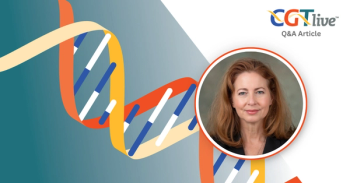
Celularity Expands Natural Killer Cell Therapy Trial to Relapsed/Refractory AML Following Patient Conversion
Conversion from MRD positivity to MRD-negative disease in a high-dose patient prompted the expansion of the trial population.
Celularity, a clinical-stage biotechnology company, has announced that it is expanding its phase 1 study (NCT04310592) of CYNK-001, an off-the-shelf allogeneic unmodified natural killer (NK) cell therapy, to include patients with relapsed/refractory
The expansion follows a case of conversion from MRD-positive disease to MRD negativity in a patient with NPM-1–positive, FLT3-negative AML who had received 5.4 billion CYNK-001 cells, the highest dose level currently being assessed. The patient did not experience a dose-limiting toxicity (DLT) and had good-risk cytogenetics.
After primary induction treatment with 7+3 chemotherapy failed, the patient received second induction treatment followed by high-dose cytarabine consolidation. The patient experienced a complete clinical response (CR); however, the MRD was persistent and did not clear after 4 months of azacitidine; MRD was confirmed on a marrow biopsy.
The patient then entered the phase 1 trial and received lymphodepletion before receiving 1.8 billion CYNK-001 cells on days 0, 7, and 14 in the outpatient setting, totaling to 5.4 billion CYNK-001 cells. On day 28, the patient not only had confirmed conversion from MRD-positive to MRD-negative disease, but CYNK-001 cells were present in both the peripheral blood and bone marrow.
“The absence of DLT to date in the phase 1 trial enables us to continue with our scheduled dose escalation and to expand the trial to include patients with [relapsed/refractory] AML,” said Robert J. Hariri, MD, PhD, founder, chairman, and CEO of Celularity. “In addition, the demonstrated ability to deliver a total [natural killer] cell dose of 5.4 billion cells in the outpatient setting without DLT and the observation of achieving a conversion from an MRD-positive to MRD-negative state on bone marrow examination with CYNK-001 cells persisting in bone marrow and blood at 28 days after day 0 infusion, is compelling and supports our trial dose escalation and indication expansion.”
To date, no DLTs have been observed at any of the dose levels, including the total dose levels of 1.8 billion, 3.6 billion, and 5.4 billion CYNK-001 cells on days 0, 7, and 14, respectively, the company noted.
Celularity is developing off-the-shelf allogeneic therapies that are derived from postpartum human placenta. CYNK-001 is being investigated in solid and hematologic malignancies, as well as infectious diseases. The cryopreserved allogeneic off-the-shelf cell therapy is enriched for CD56+/CD3– NK cells that are expanded from human placental CD34+ cells.
In the open-label, multi-dose, phase 1 trial, investigators are evaluating the maximum-tolerated dose (MTD) or maximum-planned dose of CYNK-001 in an estimated 22 patients with AML.2 The estimated completion date of the trial is January 3, 2022.
To be eligible for enrollment, patients must have primary or secondary AML who are in first of second morphological CR, morphological CR with incomplete hematologic recovery, or morphologic leukemia-free state as defined by the European LeukemiaNet recommendations for AML Response Criteria. Additional eligibility criteria include MRD positivity, between the ages of 18 and 80 years old, an ECOG performance status of 2 or lower, and the ability to be off immunosuppressive therapy for at least 3 days prior to CYNK-001 infusion.
Prior central nervous system involvement is permitted if it was treated, and cerebral spinal fluid is clear for at least 2 weeks prior to start of lymphodepletion.
Those who have any significant medical conditions that would prevent them from participating on the trial, laboratory abnormalities, bi-phenotypic acute leukemia, acute promyelocytic leukemia, inadequate organ function, autoimmune disease, and uncontrolled graft-vs-host disease or GVHD requiring corticosteroids, among other factors, were excluded from enrollment.
Patients are administered cyclophosphamide and fludarabine followed by CYNK-001 at 3 varying dose levels on days 0, 7, and 14. The primary end points of the trial are the number of patients who experience a DLT, MTD, and frequency and severity of adverse effects. Secondary outcome measures include the number of patients who convert from MRD positivity to negativity, time to and duration of MRD response, progression-free survival, time to progression, duration of morphologic complete remission, and overall survival.
In their announcement, Celularity noted that it intends to continue dose escalation in the MRD indication to a total 9.0 billion CYNK-001 cells in addition to expanding the study to include those with relapsed/refractory AML.
To enhance the persistence of CYNK-001 therapy, the trial’s expansion arms of MRD and relapsed/refractory AML will comprise an augmented lymphodepletion protocol of 3600 mg of cyclophosphamide and 120 mg of fludarabine given over the course of 4 days compared with 900 mg of cyclophosphamide and 75 mg of fludarabine over 3 days. The dosing schedule analysis is used as a method to increase post-lymphodepletion interleukin (IL)-15 levels and to also add subcutaneous IL-2.
REFERENCES
1. Celularity announces expansion of human placental hematopoietic stem cell derived natural killer cells (CYNK-001) phase 1 trial in patients with acute myeloid leukemia. News release. Celularity. June 29, 2021. Accessed June 29, 2021.
2. Natural killer cell (CYNK-001) infusions in adults with AML (CYNK001AML01). ClinicalTrials.gov. Updated March 2, 2021. Accessed June 29, 2021. https://clinicaltrials.gov/ct2/show/NCT04310592
Newsletter
Stay at the forefront of cutting-edge science with CGT—your direct line to expert insights, breakthrough data, and real-time coverage of the latest advancements in cell and gene therapy.


















































